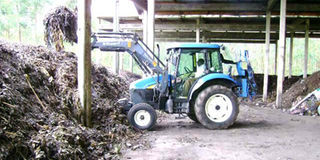Low fertiliser use hindering growth

A tractor shoves garbage used to process manure at a factory in Fort Portal. Ugandan farmers prefer organic means to improve soils and increase yields other than use of chemical fertilisers. File Photo.
What you need to know:
While greater fertiliser use improves soils and boosts yields, there is a low adoption by farmers. Yet increase in the use would contribute to economic growth through agricultural productivity.
With depletion of nutrients, the soils are slowly losing their ability to support crop growth thereby affecting the yields and the productivity of the farmers. Though the application of fertilisers is a way to overcome this challenge but few farmers in Uganda have adapted this.
Therefore, it is advisable for farmers to use fertilisers on their land if they are to get better output especially on types of land, which are experiencing depletion.
High population
Dr Lastus Serunjogi Katende, a plant breeder and Technical Advisor, Cotton Development Organisation, observes Ugandan farmers make very little use of fertiliser compared to other countries in Sub Saharan Africa yet the soils are getting depleted as a result of overcropping and overgrazing.
Although areas like Kasese and Kabarole Districts in the Mt Rwenzori region and mountain ranges in Mbale still have fertile soil, they are faced with a high population growth rate.
If farmers are reluctant to use fertilisers, they should practice either crop rotation or ensure the soils are left to rest between planting of crops.
Legumes such as beans, cowpea and groundnuts and some tree species have the ability to fix nitrogen from the air, which is transferred to the soil through their root nodules by bacteria called rhizobium. But cereals such as maize, millet, sorghum and rice behave differently. There is, therefore, need to apply fertilisers with these crops for better yields.
“Sometimes the farmers are not aware that they are applying fertilisers because some scientists mix it on specific types of seeds and when planted, the crops fix the nitrogen into the soil,” Serungoji said. “This is actually a good way of doing it due to reluctance of farmers.”
Dr Serunjogi noted three categories of fertilisers. First, those that contain Nitrogen, Phosphorus and Potassium (NPK), which manufacture proteins in plant tissues and seeds. It is applied during planting at the seed base. Second, Urea fertiliser, which is also a good source for nitrogen, which is mostly applied to crops such as cotton, maize rice and sorghum. Third is lime fertiliser, which helps increase calcium in acidic soils.
Lack of information
According to him, a number of cotton farmers growing cotton are adopting the use of fertilisers. The Uganda Ginners Association is cooperating with Uganda Cotton Development Authority to purchase fertilisers, which are sold to farmers at reduced prices.
Mr Okasai Opolot, Director of Crop Resources, Ministry of Agriculture, Animal Industry and Fisheries, said farmers of tea and sugarcane as well as in the flower sector mostly use organic fertilisers while smallholder farmers mostly use generic fertilisers which are organic.
Opolot says, it is good to use the organic ones made out farm refuse like cattle dung but whether it adds value to the crop is questionable. The average use of fertilisers in Uganda has been equated to one kilogramme per acre.
A study on central and eastern Uganda by the International Food Policy Research Institute found most farmers lack information and regard inorganic fertilisers as costly and inefficient. It showed that farmers in Masaka District use fertiliser mostly on coffee, those in the districts around Kampala use it on vegetables, while those in Iganga District, it is on maize and those in the districts on the slopes of Mount Elgon use on both maize and Arabica coffee.
“Although Uganda is one of the countries in Africa with the highest level of soil nutrient and mining , fertiliser use remains very low yet increased use of inorganic fertiliser in combination with other improved agricultural technologies such as high yielding seeds, good agronomy practices and irrigation can improve agricultural productivity,” it stated.
Satisfactory level
The 2005/2006 Uganda National Household Survey rated farmers’ fertiliser use at 1 per cent of the households surveyed which were applying inorganic fertilisers.
Yet the World Bank estimated an agricultural productivity growth rate of 4 per cent per annum is required to stimulate a satisfactory level of economic development with annual increase of labour and land productivity of 1.5 per cent and 3 per cent respectively.
Therefore developing a sustainable, competitive input supply and output marketing system is essential to stimulating fertiliser use in Uganda.


